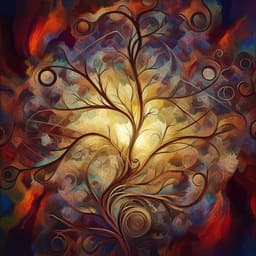
Medicine and Health
Cortical structural and functional coupling during development and implications for attention deficit hyperactivity disorder
S. M. Soman, N. Vijayakumar, et al.
This groundbreaking neuroimaging study reveals significant insights into the contrasting development of structure-function coupling in children with ADHD compared to their typically developing peers. Conducted by Shania Mereen Soman, Nandita Vijayakumar, Phoebe Thomson, Gareth Ball, Christian Hyde, and Timothy J. Silk, the findings highlight atypical connectivity patterns that may influence cognitive development in ADHD.
~3 min • Beginner • English
Introduction
The study investigates how structure-function coupling (the association between anatomical white matter connectivity and functional connectivity) develops from late childhood to mid-adolescence, and how this development differs in children with ADHD. Prior work suggests lower coupling in higher-order association cortex and higher coupling in primary sensory regions; limited longitudinal evidence indicates increasing coupling in frontal regions through youth and links to executive function. ADHD has been associated with atypical structural and functional network organization, particularly within higher-order cognitive and sensory systems, yet longitudinal trajectories of coupling in ADHD are largely unknown. The authors hypothesized that typically developing children would show age-related increases in coupling in higher-order cognitive regions, and that children with ADHD would differ from controls in both baseline coupling and developmental trajectories in higher-order cognitive and sensory regions.
Literature Review
Cross-sectional studies indicate an inverse relation between coupling magnitude and functional complexity: lower coupling in higher-order association areas (frontal, limbic) and higher coupling in sensory systems (e.g., visual). Age-related changes in structural and functional connectivity tend to be aligned within networks (e.g., DMN), implying structural maturation supports functional communication. Adult studies report strong SC–FC relationships in fronto-parietal-cerebellar circuits. In youth, two cross-sectional studies found no age effects on coupling in DMN, frontoparietal, or salience networks, whereas a single longitudinal study showed increasing coupling in frontal regions across childhood–adolescence and associations with executive functions. In ADHD, aberrant structural and functional organization has been reported across higher-order and sensory networks, but few studies have examined SC–FC coupling, with inconsistent cross-sectional findings and a lack of longitudinal data, underscoring the need for developmental investigations of coupling in ADHD.
Methodology
Design and participants: Community-based longitudinal cohort (Rewiring of the Children’s Attention Project, NICAP) in Melbourne, Australia. Children aged 9–14 years with up to three MRI waves ~18 months apart. ADHD status determined by parent/teacher Conners 3 ADHD Index screening and parental diagnostic interview (NIMH DISC-IV) at recruitment and at first imaging wave. Children meeting ADHD criteria at either wave were included in the ADHD group; controls screened negative and did not meet ADHD diagnostic criteria. Initial cohort: 175 individuals (84 controls, 91 ADHD) yielding 278 observations (139 per group). After quality control, the final sample included 178 participants and 278 scans (131 ADHD, 147 control) across three waves. At any wave, ~21% of ADHD participants were medicated (mostly atomoxetine; a minority on stimulants; some on SSRIs). Exclusion criteria included excessive head motion in rs-fMRI (mean frame-wise displacement > 0.5 cm), missing field maps, and poor-quality DWI; no age distribution differences between included/excluded, but excluded ADHD participants had more severe symptoms.
MRI acquisition: 3D T1-weighted MPRAGE, 1 mm isotropic, matrix 256×256, FOV 256×256 mm, TR = 2500 ms, TE = 1.9 ms, TI = 1000 ms. Mock scan used for acclimatization.
Functional preprocessing: FSL 5.0.9 pipeline: discard first 4 volumes, motion correction (MCFLIRT), B0 unwarping, 5 mm FWHM smoothing, affine normalization to MNI, registration via T1 (FLIRT/FNIRT), high-pass filtering (cutoff = 100 s). ICA-based denoising (MELODIC), manual classification on a subset to train automated component classification and remove noise components.
Structural preprocessing: DWI processed with MRtrix3 (with FSL/ANTs): denoising, Gibbs unringing, eddy-current and bias-field correction, brain masking. Motion quantified (mean reversible displacement) included to reduce motion confounds. Response functions estimated for WM/GM/CSF; fiber orientation distributions computed via spherical deconvolution.
Connectome construction: Cortical parcellation with HCP-MMP (360 regions). Parcellation mapped to individual surface space (FreeSurfer). Functional connectivity (FC) computed as Pearson correlation between ROI time series (CONN toolbox). Structural connectivity (SC) derived from whole-brain tractography using anatomically constrained tractography; streamline counts used as SC weights following BATMAN/MRtrix pipelines.
Structure–function coupling metric: For each region at each timepoint, Spearman’s rank correlation between the non-zero elements of that region’s SC profile and its FC profile to all other regions. Implementation available at https://github.com/shaniasom/SC_FC_coupling/blob/main/SC_FC_coupling.R.
Statistical analysis: Generalized additive mixed models (GAMMs; R mgcv) assessed developmental trajectories. Covariates included age, sex, medication, and scanner upgrade effects; random effects accommodated longitudinal data. Model comparisons via likelihood ratio tests and AIC, with smooth term basis dimension k = 4. Multiple comparisons controlled using FDR (p < 0.05). Whole-brain maps and trajectory plots generated in PySurfer and RStudio.
Key Findings
- In typically developing children (ages 9–14), structure–function coupling increased with age across widespread cortex, notably in higher-order cognitive regions (prefrontal, anterior cingulate, posterior cingulate, inferior parietal, medial temporal) and sensory/visual regions. Higher-order regions showed continued increases from 9 to 14 years; sensory/visual regions increased from 9 to ~12 years then plateaued.
- Children with ADHD exhibited weaker coupling than controls across 9–14 years in left superior temporal gyrus, right inferior parietal cortex, and right medial prefrontal cortex (FDR-corrected).
- Group-by-age interactions indicated ADHD-specific increases in coupling with age in bilateral inferior frontal gyrus, left medial prefrontal cortex, left superior parietal cortex, left precuneus, left inferior temporal cortex, right inferior parietal cortex, right mid-cingulate, right medial temporal cortex, and a right visual region, whereas typically developing children showed no change in these regions.
- Sample and data: Up to three waves per participant; total 278 observations; age range 9–14 years; FDR threshold p < 0.05 used for statistical significance.
Discussion
The findings support the hypothesis that structure–function coupling strengthens through late childhood to mid-adolescence, particularly in association cortex implicated in executive control (DMN, salience, frontoparietal networks), consistent with protracted maturation of higher-order systems. Sensory and visual systems exhibited earlier increases and plateau, aligning with earlier maturation of primary systems. In ADHD, reduced coupling in DMN and salience-related regions (e.g., medial prefrontal, inferior parietal, superior temporal) indicates atypical coordination between white matter architecture and functional communication that may underlie cognitive and attentional difficulties. The ADHD group showed distinct developmental trajectories with increasing coupling in several frontoparietal, default, dorsal attention, temporal, cingulate, and visual areas relative to controls, potentially reflecting compensatory neural adaptations or delayed maturation. Overall, the results highlight joint maturation of SC and FC in typical development and atypical coupling patterns across key networks in ADHD, addressing the study’s central questions about developmental changes and group differences in structure–function coupling.
Conclusion
This longitudinal study demonstrates widespread, age-related increases in cortical structure–function coupling from late childhood to mid-adolescence, with protracted development in higher-order cognitive networks and earlier maturation in sensory/visual systems. Children with ADHD exhibit reduced coupling in DMN and salience-related regions and distinct developmental trajectories marked by increasing coupling in frontoparietal, default, dorsal attention, temporal, cingulate, and visual regions compared to controls. These findings advance understanding of coordinated SC–FC maturation in typical development and reveal atypical coupling patterns in ADHD that may contribute to symptomatology. Future research should link coupling trajectories to behavioral and clinical outcomes, examine microstructural contributors (e.g., myelination, axon caliber), assess causal relationships between SC and FC maturation, and explore effects of treatment and symptom heterogeneity on coupling development.
Limitations
- The coupling measure is correlational and does not establish causality between structural and functional maturation.
- Structural connectivity was indexed by streamline count; unmeasured microstructural properties (e.g., myelination, axon diameter) may drive coupling changes.
- Some data exclusions occurred (e.g., motion, missing field maps, poor DWI quality); excluded ADHD participants had more severe symptoms, potentially biasing group comparisons.
- A proportion of ADHD participants were medicated; although medication was included as a covariate, residual confounding is possible.
- The age range (9–14 years) limits generalizability beyond mid-adolescence; earlier childhood and later adolescence/young adulthood were not examined.
- Behavioral associations with coupling trajectories were not directly tested, limiting interpretation of functional significance for cognition and symptoms.
Related Publications
Explore these studies to deepen your understanding of the subject.







